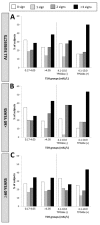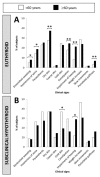Subclinical Hypothyroidism: is it Really Subclinical with Aging?
- PMID: 31164997
- PMCID: PMC6538219
- DOI: 10.14336/AD.2018.0817
Subclinical Hypothyroidism: is it Really Subclinical with Aging?
Abstract
No recent study has focused on clinical features of subclinical hypothyroidism (SCH), especially in older patients. TSH measurement has remarkably evolved these last 20 years and thus reconsideration is needed. In our prospective multicenter study (2012-2014) including 807 subjects aged <60 years (<60y) and 531 subjects ≥60 years (≥60y), we have monitored 11 hypothyroidism-related clinical signs (hCS) together with TSH, FT4, FT3 and anti-thyroperoxidase antibodies values. hCS expression has been compared in patients with SCH vs euthyroidism in each age group. The number of hCS above 60y of age were found to be more elevated in the euthyroid population (1.9 vs 1.6, p<0.01) than in the SCH population (2.3 vs 2.6, p=0.41) while increase in hCS is limited to SCH subjects in the <60y group (p<0.01). The percentage of subjects with at least 3 signs increased with SCH in the <60y group (42.6% vs 25.0%, p<0.01) but not ≥60y (34.4% vs 33.9%, p=0.96). In older individuals, only three hCS could be related to both SCH and a decreased T3/T4-ratio (0.26 vs 0.27, p<0.01), suggesting either a reduced activity of TSH, or an adaptive response with aging. While hCS are clearly associated with SCH in patients <60y, they are not so informative in older subjects. TSH measurements carried out on the basis of hCS need to be interpreted with caution in aged patients. A reassessment of the TSH reference range in older patients is clearly needed and should be associated to more appropriate monitoring of thyroid dysfunction.
Keywords: TSH; aging; symptoms; thyroid deficiency.
Figures




References
-
- Canaris GJ, Manowitz NR, Mayor G.,Ridgway EC (2000). The Colorado thyroid disease prevalence study. Arch Intern Med,160:526-534. - PubMed
-
- Hollowell JG, Staehling NW, Flanders WD, Hannon WH, Gunter EW, Spencer CA, Braverman LE (2002). Serum TSH, T(4), and thyroid antibodies in the United States population (1988 to 1994): National Health and Nutrition Examination Survey (NHANES III). J Clin Endocrinol Metab, 87:489-499. - PubMed
-
- Asvold BO, Vatten LJ, Bjøro T (2013). Changes in the prevalence of hypothyroidism: the HUNT Study in Norway. Eur J Endocrinol, 169:613-620. - PubMed
LinkOut - more resources
Full Text Sources
Miscellaneous
